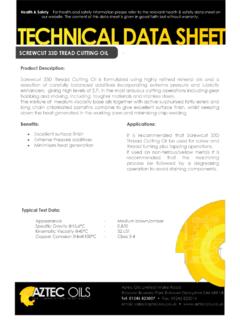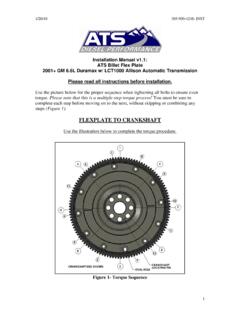Transcription of Automation of Continuous Spontaneous Alternation …
1 Automation of Continuous Spontaneous Alternation to Increase the Throughput for In Vivo Screening of Cognitive Enhancers. Optimization of the Ethovision System for the Y-maze Test in Mice Eric Detrait Catherine Brohez Etienne Hanon Marc De Ryck UCB Pharma , CNS Research, Chemin du Foriest, B-1420 Braine-l Alleud, Belgium ABSTRACT Continuous Spontaneous Alternation in a symmetrical Y-maze is widely considered as a measure of spatial working memory in rodents, and is used as an entrance screening test for cognitive enhancers. The task consists of a single 8-min session during which arm visits and sequence of arm entries are continuously recorded. Using EthoVision XT, we describe the implementation and validation of an automated scoring procedure for Continuous Spontaneous Alternation in mice in a Y-maze. We optimized the design of the arena setting to avoid false arm entries, and developed an automated analysis program in order to extract from the EthoVision export file the sequence of arm entries and the number of alternations.
2 We show that, after optimization, 100% agreement was reached between the automated output and human observers in terms of arm entries, sequence of entry and Alternation percentage. We also demonstrate that several Y-mazes can be run in parallel without influencing mouse Alternation behavior, and that the automated system is suitable for pharmacological testing. Author Keywords Y-maze, EthoVision, Spontaneous Alternation , drug screening. INTRODUCTION Spontaneous Alternation in rats and mice refers to the natural tendency of rodents to spontaneously choose alternate arms in a Y- or T-maze. This behavior has been described about 80 years ago [1]. Spontaneous Alternation behavior has been ascribed to the operation of a variety of mechanisms, but regardless of this ethological function, it is evident that the animal must remember which arm it had entered on a previous occasion to enable it to alternate its choice on a following trial.
3 Therefore, Spontaneous Alternation has been embraced by behavioral pharmacologists as a quick and relatively simple test of spatial working memory, devoid of fear, reward or reinforcers (review by Hughes, 2004 [2]). Free-running or Continuous Spontaneous Alternation in symmetrical Y-mazes was first applied to the study of drug effects about 30 years ago [3,4]. The basic procedure allowed individual rats and mice free access to the three arms of the maze for several minutes during which time sequences of entries of the arms were recorded. From these sequences, proportions of arms entered that were different from those previously visited were calculated to produce an Alternation score. In the most recent form, which is widely used to study spatial working memory, animals are usually given an 8-min unrestrained trial in a symmetrical Y-maze [5].
4 Administration of scopolamine (intraperitoneally) or amyloid (intracerebrally) generates deficits of performance in the Y-maze. These deficits can be prevented by acetylcholine esterase inhibitors and by sigma-1 agonists [6,7]. In the present work, using EthoVision XT, we describe the implementation and validation of an automated scoring procedure for Continuous Spontaneous Alternation of mice in a Y-maze. MATERIAL AND METHODS Animals Young male Swiss mice were used (weighing 24-28 g, about 4-week old, purchased from Janvier France). They were group-housed in polypropylene cages (type III H Macrolon, with sterile aspen bedding) under the following standard conditions: 22 2 C, light/dark cycle 12 h/12 h - 6 am-6 pm, 55 15 % humidity, ultra filtered water and ad _____ Permission to make digital or hard copies of all or part of this work for personal or classroom use is granted without fee provided that copies are not made or distributed for profit or commercial advantage and that copies bear this notice and the full citation on the first page.
5 For any other use, please contact the Measuring Behavior secretariat: Proceedings of Measuring Behavior 2010 (Eindhoven, The Netherlands, August 24-27, 2010)Eds. Spink, F. Grieco, Krips, Loijens, Noldus, and Zimmerman141 libitum food (SDS RM1(E)SQC. The cages were located in an air-conditioned animal housing room (15-20 air changes per hour) in a type 1 conventional animal facility. All experiments were carried out according to the European guideline 86/609/CEE and 2003/65/CE and the Belgian legislation from August 14th, 1986 and its amendments. All experiments were approved by the UCB ethical committee. Y-Maze Task The Y-maze consisted of three arms of equal size. Each arm was a V-shape corridor made of white PVC. The arms measured cm long, 3 cm wide and 13 cm high, and were oriented at 60 angles from each other. The arena was cleaned using Umonium (Huckert s international) between two trials in order to avoid odor trails.)
6 The Y-maze test was performed under moderate lighting conditions (200 lux), with moderately loud background music. Mice began the single trial at the end of one arm, and were allowed to freely explore the Y-maze during 8 min. Number and sequence of arm visits were recorded either manually by the observer or by means of EthoVision XT. Alternation was defined as a consecutive entry in three different arms . The Alternation percentage was computed with the following formula: number of alternations divided by total number of arm visits minus 2. RESULTS Optimization of Arena Settings EthoVision is a video tracking system, which first captures video, and then analysis the subject tracks using subject location and movement. The track analysis is based on arena settings. The arena settings define a variety of zones or locations inside the arena, for which a behavior will be measured.
7 Behavior is here defined in terms of locomotion or position (e. g.: moving in, or around, a zone; being close, or far, from a location). The intuitive arena setting for a Y-maze task consisted of one central zone and three rectangular zones corresponding to each one of the three arms. Arm exploration was defined as entering at least the first third of an arm. Such settings did not reach satisfactory accuracy between automated and observer scoring, and provided on average 20% variation between the two scoring techniques. To optimize the accuracy of the automated scoring, additional zones were drawn as shown in Figure 1. The additional zones split the central zone of the maze between a central triangle located at the center of the three arms, and the proximal area of each arm. This proximal area covered approximately the first third of the arm.
8 The reason to include the first third of the arm into the central zone was that part of normal rodent behavior consisted of repeatedly going around within the central zone of the Y-maze. In this case, rodents did not really explore any arm. Without the definition of the proximal arm area, the automated system considered any animal located in this area as exploring the arm, while it was not. Furthermore, we designed an Excel-VBA macro to analyze the sequences of arm visits. EthoVision XT5 generated a track export file, which was first decoded by the Noldus Excel macro in order to provide the position of the animal relative to the zone areas defined in the arena settings. The position was given every 4/100 sec in a binary format, which was presence/ absence of the animal in any of the zone areas.
9 Our Excel-VBA macro used the list of the positions of the center point as input. A new visit of an arm was recorded each time a visit of a distal area was followed by an entry in the central area. An arm entry was defined as center point of the mouse entered into the distal part of the arm (A, B, or C). Similarly, a new arm entry was only considered when the mouse center point left the proximal part of the arm (Ap, Bp, or Cp). The macro first detected the inter-zone transitions, zone transition being defined as a passage through the central area. In order to extract Alternation from inter-zone transition, each visit to an arm was associated with a numerical code. The code took the values 1, 2 or 4 according to the arms visited. The successive transitions associated with a sum of codes equal to 7 corresponded to one Alternation defined as a successive visit to the three arms of the Y-maze.
10 For instance, the following sequence of mouse movements: center Ap - A Ap A Ap center- Bp B was translated by the macro into the following arm transition : A B. The Optimized Arena Settings Increased the Accuracy of Automated Scoring Mice were run during a 8-min session in the Y-maze. Their alternations were scored by EthoVision XT using the optimized arena settings or by visual observations. Figure 2 showed for each animal the Alternation percentage obtained Zone AZone ApZone BpZone BZone CZone CpCentral triangleArena 2 Zone AZone ApZone BpZone BZone CZone CpCentral triangleArena 2 Figure 1. Optimized arena settings to increase the accuracy of the automated scoring. The arm zone, defined as the distal 2/3 of each arm were labeled zone A, B, and C. The proximal areas of each arm were labeled zone Ap, Bp, and Cp. The central zone was therefore divided into the central triangle and three proximal zones.





